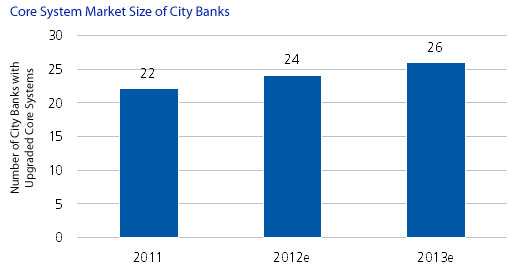Core Banking Solutions for Small and Midsize Banks in China
Abstract
China’s city banks—the third tier banking market in China—have grown rapidly in recent years. Total bank assets grew 38% year-on-year in 2011, and will reach US$2 trillion by 2013. To cope with growth and compete more effectively with both domestic and foreign banks, China’s city banks need to upgrade their core banking systems.
Most of China’s large banks have finished their core banking upgrades. In the next few years, the city banks will play an important role in the core banking market, because many of these banks have been using their core systems for more than five years. A majority of the city banks still use second-generation core systems that focus on transaction processing. But factors such as the reorganization and mergers between city banks, their development into nationwide banks, the centralized processing of banking operations, reforms in process banking, customer-centric marketing, pricing, service and processing, and a need for faster and more complex product design capabilities and multiple-channel integration capability are pushing city banks to upgrade their core banking systems.
In a new report, Core Banking Solutions for Small and Midsize Banks in China, Celent examines the current core banking systems, trends, competitive landscape, and market share of both domestic and foreign vendors in the Chinese core banking market. The report also provides brief profiles of six domestic vendors of core banking systems.

“The greatest obstacle to Chinese banks adopting foreign core systems is their need to reform their organizational structure and to reengineer process flows. Chinese banks can adapt to these changes smoothly only if vendors strengthen their ability to communicate the new paradigm to the banks,” says Hua Zhang, analyst with Celent’s Asian Financial Services group and author of the report. “Foreign vendors also need to improve the speed and performance of their products because city banks in China generally handle more customers than foreign banks.”

